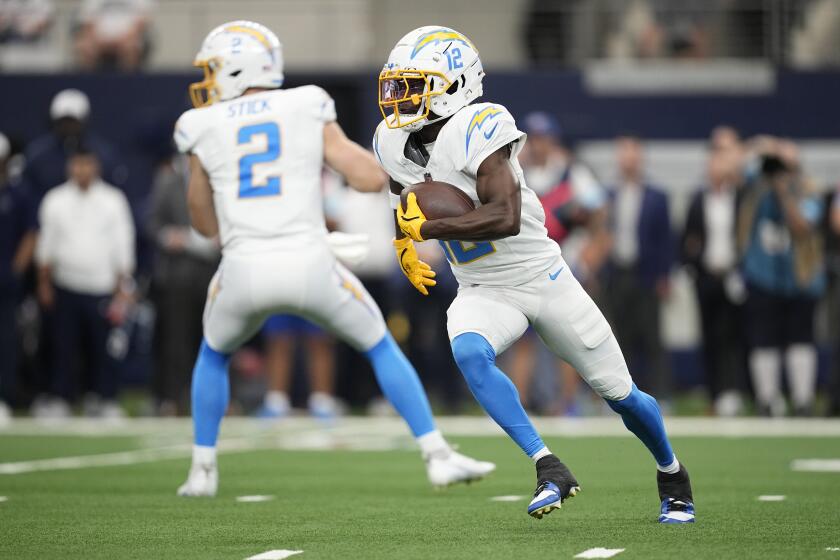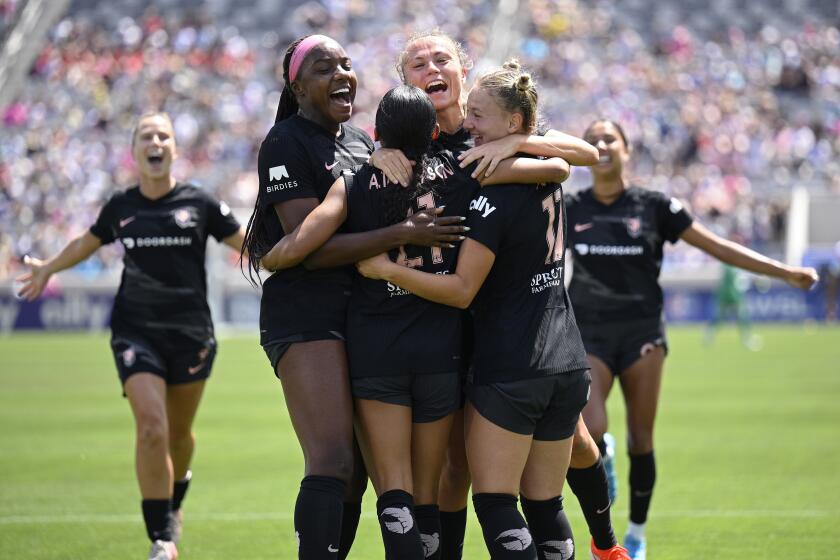More Than a Net Loss for Tennis
The members of Tennis LA know their Mid-City tennis club is scheduled to be shut down to make room for a massive apartment complex next to Park La Brea.
They know because a crane and other heavy equipment showed up on the property one day, and now the tennis instructors are pondering where they will teach when the decades-old club shuts its doors today.
But as news of the closure spread, members wrote letters, made calls to elected officials, even penned a protest song.
They want the club to stay right where it is, the way it is: an affordable club that attracts the wealthy and the working class, a meeting ground at the center of the city where paths cross and converge in easy, fluid ways.
“Every week you meet people there you couldn’t meet if you went to some club where not everyone could join,” said Janelle Hawley of Hancock Park. “It’s a place where all children can go, not just those whose parents have a lot of money. Everybody is welcome, any color, any age.”
Without it, she added, “tennis becomes elite again.”
But the club sits on prime real estate for wealthy, young professionals looking to live in the Miracle Mile and Fairfax districts. Where the tennis club now stands, the owners of the land, Casden Properties, plan to build one of the city’s largest new apartment complexes, complete with high-speed Internet wiring, a business center and a concierge.
So far no protests to elected officials or letters or songs have managed to change that.
“There’s nothing we can do to prevent it from being torn down,” said Renee Weitzer, chief planning deputy for Los Angeles City Councilman John Ferraro, who represents the area. “The owners have the right to build on their property. I know a lot of people are disappointed, but we don’t have the power that people think we have.”
Club members are holding on not only to tennis, but also to the relationships formed at the club, the sense of place created.
“It is more than a tennis club,” said Maggie Jones, who spent a recent Saturday morning playing and talking with friends. “It’s a family. As we lose these things, we lose more and more of the good in L.A.”
Algonquin West is how Jones describes the groups seated at the tables next to the courts on Saturday mornings. They might include a studio head, a doctor, a single mother, a Nigerian immigrant, a former NBA player, all talking tennis and life.
“Nobody is different than anybody else,” said Jones. “You don’t know if you’re talking to the head of a studio or what, because the conversation is on a personal level.”
Jones, who is African American, has played tennis at the club for 30 years. “I was a size 6 when I first came here, if that puts it in perspective,” joked the woman, who is no longer a size 6.
Her first tennis pro was Jim McDaniel, who taught her “not to play like a girl.” Her daughter’s 13th birthday party was held in the club’s cafe. She and friends have experienced births, deaths, weddings--sometimes between club members--and divorces.
More Than Tennis
Some of the regulars may never pick up a racket. A group of older men come to play cards and kibitz--onetime actors and the ex-NBA player who tell stories about road trips and Motown parties.
Belonging to a club had never appealed to Josh Schweitzer. Country clubs were elitist, separatist. But this is no typical tennis club.
“It’s not just a bunch of white people sitting around, being in the ‘country club,’ ” said Schweitzer, whose son also plays there. “It’s the most amazing United Nations of tennis that I’ve ever experienced in my 35 years of playing tennis. . . . To have a place where there’s a community like that is a rarity in this time.”
Tennis LA averaged about 1,400 visits a week, said Tim Ricks, the manager. With low fees, the well-kept, open-to-the-public facility drew people from all over the city. Each day, he said, as many as 20 people call about the closing.
Over the years, a big part of the appeal for families was the club’s philosophy toward children.
Clay Redwood started playing at the club when he was 10 years old, with an old racket given to him by his father. He advanced from playing at the club to working in the club office to running clinics, and eventually to becoming a private instructor.
“I stayed out of trouble playing tennis and it’s been my life, basically,” Redwood said.
Now Redwood, 38, organizes junior tennis tournaments, clinics, team tennis and a summer youth camp. The club offered scholarships for those who could not afford the weekly fee for camp.
Redwood said shy, withdrawn kids learn confidence from mastering tennis. Energetic kids find a positive place to channel their energy. Some are ranked players, and several have gone to college on tennis scholarships. Children were allowed to play free on courts that were not being used.
“They’re really learning how to interact with each other,” Redwood said. “We try to instill a respect for the game and in turn I think that translates into respect for other things in their life beyond tennis: themselves, other people, their generation.”
“We come from an Orthodox background,” said Ellen Hausman, whose two children played tennis at the club. “Just to have my kids integrate with other kinds of people in a safe environment is special. It’s not just racial, it’s intergenerational. You see them hanging out with people 70, 75 years old.”
One recent Saturday, Redwood gave a lesson to 10-year-old Alana Johnson of View Park. On the next court Sue Bae, a tennis champion in South Korea, gave lessons to a young girl in Korean.
“Give him a haircut, Lolli,” Alana’s mother, Deborah Johnson, called from the sidelines. “Good shot!”
“If you get girls on the courts with rackets,” Johnson said, “they’re not going to be cruising the malls looking for boys.”
The loss of the club will extend beyond the members. The club was used for United States Tennis Assn. tournaments and charitable events. Private schools and the Los Angeles Unified School District used the facilities for their tennis tournaments as well.
Mothers and daughters spent so much time at the club on the weekends and during the week that Johnson started taking lessons with Redwood as well. And even when she wasn’t there, she didn’t worry about her daughter.
“I’m staying until 7 today,” Alana said, sitting outside the tennis shop, eating a pastrami sandwich with her friend Monique. “My mom trusts me being here.”
Then she added: “I trust myself being here. I have a feeling I’m safe here. Everybody knows me.”
Hard to Say Goodbye
This was a place where full names were not needed when talking tennis. Everybody knew Serena and Venus, Arantxa and Andre. They watched videotapes of classic matches on the club’s TV, then tried to imitate the moves.
Songwriter Dan Bern, who played tennis at the club, wrote a song that laments the loss: “I know a place where the kids come day and night/big ones and little ones, red, yellow, black and white/and they run and they sweat and they get these big blisters/and one day they might be as good as the Williams sisters.”
Plans to close the club began in the early 1990s.
Developers had originally considered the site of the Art Deco May Co. building nearby, Weitzer said. But hundreds of people showed up at meetings in protest, and the building was saved. Developers won approval in 1993 to build on properties that include the tennis club. Once the permits were granted, things stopped.
“The economy went down and nobody was building,” Weitzer said. “Everything was at a standstill . . . this and many other projects in this city. Now the economy is back. People are building, but their [permits] are good until the year 2008.”
Jones remembers talk of the city putting courts in nearby in Pan-Pacific Park. That never happened.
No new public hearings on the club were required, no efforts could change the plans.
Like a family facing tragedy, members went from denial to anger to sullen acceptance.
When the club closes, some will follow the pros wherever they go. The management of Tennis LA has made arrangements for members to play at another club that they manage.
Everybody agrees that wherever they go, it will not be the same.
“It’s a huge loss,” Jones said. “It’s a lot of memory now. It’s just something you remember.”
What she hopes will last after the club is gone are the friendships she has made over three decades.
“I’m taking everybody with me,” she said.
More to Read
Go beyond the scoreboard
Get the latest on L.A.'s teams in the daily Sports Report newsletter.
You may occasionally receive promotional content from the Los Angeles Times.






